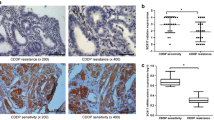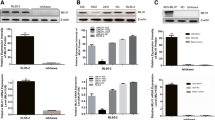Abstract
This study aimed to investigate the function of lncRNA HEIH on promoting endometrial cancer cells’ tolerance of paclitaxel (PTX). LncRNA HEIH expression was measured by QRT-PCR in endometrial cancer tissues, human healthy tissues and cell lines. The PTX-resistant endometrial cancer cells (Ishikawa-RE and HHUA-RE) were intermittently exposed to increase concentrations of PTX and were constructed as evidenced by MTT assay. Besides, the specific siRNA of HEIH (siHEIH) and pcDNA3.1-HEIH plasmid transfection were utilized to alter the expression of HEIH in the cells and investigate the effects of HEIH on resistance to PTX in endometrial cancer cells. Moreover, MTT, colony formation and apoptosis analysis were taken advantage to evaluate cell viability and proliferation when treated with PTX. Then, differential genes in PTX-resistant and HEIH-knock-down PTX-resistant endometrial cancer cells were screened out by microarray analysis. Finally, gene-set enrichment analysis was used to predict the promising signaling pathway of HEIH and western blotting analysis were performed to verify the relevant genes expression of MAPK signaling pathway. LncRNA HEIH, the dysregulation of which involved in production of drug-resistance, was overexpressed in PTX-resistant endometrial cancer cells. Up-regulating HEIH would activate MAPK pathway, promote chemo-resistance of endometrial cancer cells and enhance cell proliferation and viability, whereas silencing HEIH depressed the MAPK signaling pathway, contributed to restoring chemo-sensitivity to PTX and repressed cell physiological process. Down-regulating lncRNA HEIH expression reversed the PTX-resistance of endometrial cancer cells through MAPK signaling pathway.





Similar content being viewed by others
References
Dong L, Zhou Q, Zhang Z, Zhu Y, Duan T, Feng Y (2012) Metformin sensitizes endometrial cancer cells to chemotherapy by repressing glyoxalase I expression. J Obstet Gynaecol Res 38(8):1077–1085. https://doi.org/10.1111/j.1447-0756.2011.01839.x
Kharma B, Baba T, Mandai M, Matsumura N, Murphy SK, Kang HS, Yamanoi K, Hamanishi J, Yamaguchi K, Yoshioka Y, Konishi I (2013) Utilization of genomic signatures to identify high-efficacy candidate drugs for chemorefractory endometrial cancers. Int J Cancer 133(9):2234–2244. https://doi.org/10.1002/ijc.28220
Viswanathan AN, Moughan J, Miller BE, Xiao Y, Jhingran A, Portelance L, Bosch WR, Matulonis UA, Horowitz NS, Mannel RS, Souhami L, Erickson BA, Winter KA, Small W Jr, Gaffney DK (2015) NRG oncology/RTOG 0921: a phase 2 study of postoperative intensity-modulated radiotherapy with concurrent cisplatin and bevacizumab followed by carboplatin and paclitaxel for patients with endometrial cancer. Cancer 121(13):2156–2163. https://doi.org/10.1002/cncr.29337
Galaal K, Al Moundhri M, Bryant A, Lopes AD, Lawrie TA (2014) Adjuvant chemotherapy for advanced endometrial cancer. Cochrane Database Syst Rev 5:CD010681. https://doi.org/10.1002/14651858.CD010681.pub2
Reyes HD, Miecznikowski J, Gonzalez-Bosquet J, Devor EJ, Zhang Y, Thiel KW, Samuelson MI, McDonald M, Stephan JM, Hanjani P, Guntupalli S, Tewari KS, Backes F, Ramirez N, Fleming GF, Filiaci V, Birrer MJ, Leslie KK (2017) High stathmin expression is a marker for poor clinical outcome in endometrial cancer: an NRG oncology group/gynecologic oncology group study. Gynecol Oncol 146(2):247–253. https://doi.org/10.1016/j.ygyno.2017.05.017
Altundag O, Dursun P, Ayhan A (2010) Emerging drugs in endometrial cancers. Expert Opin Emerg Drugs 15(4):557–568. https://doi.org/10.1517/14728214.2010.517521
Jiang SJ, Zhang S, Mu XY, Li W, Wang Y (2008) Effects of trichostatin a and paclitaxel on apoptosis and microtubule stabilization in endometrial carcinoma cells: an in vitro research. Zhonghua Yi Xue Za Zhi 88(34):2427–2431
Kuittinen T, Rovio P, Staff S, Luukkaala T, Kallioniemi A, Grenman S, Laurila M, Maenpaa J (2017) Paclitaxel, carboplatin and 1,25-D3 inhibit proliferation of endometrial cancer cells in vitro. Anticancer Res 37(12):6575–6581. https://doi.org/10.21873/anticanres.12114
Liz J, Esteller M (2016) lncRNAs and microRNAs with a role in cancer development. Biochim Biophys Acta 1859(1):169–176. https://doi.org/10.1016/j.bbagrm.2015.06.015
Philippen LE, Dirkx E, da Costa-Martins PA, De Windt LJ (2015) Non-coding RNA in control of gene regulatory programs in cardiac development and disease. J Mol Cell Cardiol 89(Pt A):51–58. https://doi.org/10.1016/j.yjmcc.2015.03.014
Bawa P, Zackaria S, Verma M, Gupta S, Srivatsan R, Chaudhary B, Srinivasan S (2015) Integrative analysis of Normal long intergenic non-coding RNAs in prostate Cancer. PLoS One 10(5):e0122143. https://doi.org/10.1371/journal.pone.0122143
Szafranski K, Abraham KJ, Mekhail K (2015) Non-coding RNA in neural function, disease, and aging. Front Genet 6:87. https://doi.org/10.3389/fgene.2015.00087
Malek E, Kim BG, Driscoll JJ (2016) Identification of long non-coding RNAs deregulated in multiple myeloma cells resistant to proteasome inhibitors. Genes (Basel) 7(10). https://doi.org/10.3390/genes7100084
Liu S, Zou B, Tian T, Luo X, Mao B, Zhang X, Lei H (2018) Overexpression of the lncRNA FER1L4 inhibits paclitaxel tolerance of ovarian cancer cells via the regulation of the MAPK signaling pathway. J Cell Biochem. https://doi.org/10.1002/jcb.28032
Zhao H, Xing G, Wang Y, Luo Z, Liu G, Meng H (2017) Long noncoding RNA HEIH promotes melanoma cell proliferation, migration and invasion via inhibition of miR-200b/a/429. Biosci Rep 37(3). https://doi.org/10.1042/BSR20170682
Yang F, Zhang L, Huo XS, Yuan JH, Xu D, Yuan SX, Zhu N, Zhou WP, Yang GS, Wang YZ, Shang JL, Gao CF, Zhang FR, Wang F, Sun SH (2011) Long noncoding RNA high expression in hepatocellular carcinoma facilitates tumor growth through enhancer of zeste homolog 2 in humans. Hepatology 54(5):1679–1689. https://doi.org/10.1002/hep.24563
He Y, Meng XM, Huang C, Wu BM, Zhang L, Lv XW, Li J (2014) Long noncoding RNAs: novel insights into hepatocelluar carcinoma. Cancer Lett 344(1):20–27. https://doi.org/10.1016/j.canlet.2013.10.021
Haque SU, Niu L, Kuhnell D, Hendershot J, Biesiada J, Niu W, Hagan MC, Kelsey KT, Casper KA, Wise-Draper TM, Medvedovic M, Langevin SM (2018) Differential expression and prognostic value of long non-coding RNA in HPV-negative head and neck squamous cell carcinoma. Head Neck 40(7):1555–1564. https://doi.org/10.1002/hed.25136
Cui C, Zhai D, Cai L, Duan Q, Xie L, Yu J (2018) Long noncoding RNA HEIH promotes colorectal cancer tumorigenesis via counteracting miR-939Mediated transcriptional repression of Bcl-xL. Cancer Res Treat 50(3):992–1008. https://doi.org/10.4143/crt.2017.226
Zhang Y, Li Z, Zhang Y, Zhong Q, Chen Q, Zhang L (2015) Molecular mechanism of HEIH and HULC in the proliferation and invasion of hepatoma cells. Int J Clin Exp Med 8(8):12956–12962
Tanaka T, Toujima S, Tanaka J (2012) Differential sensitivity to paclitaxel-induced apoptosis and growth suppression in paclitaxel-resistant cell lines established from HEC-1 human endometrial adenocarcinoma cells. Int J Oncol 41(5):1837–1844. https://doi.org/10.3892/ijo.2012.1600
Li L, Shou H, Wang Q, Liu S (2019) Investigation of the potential theranostic role of KDM5B/miR-29c signaling axis in paclitaxel resistant endometrial carcinoma. Gene. https://doi.org/10.1016/j.gene.2018.12.076
Liu Z, Sun M, Lu K, Liu J, Zhang M, Wu W, De W, Wang Z, Wang R (2013) The long noncoding RNA HOTAIR contributes to cisplatin resistance of human lung adenocarcinoma cells via downregualtion of p21(WAF1/CIP1) expression. PLoS One 8(10):e77293. https://doi.org/10.1371/journal.pone.0077293
Wang Q, Zhang W, Hao S (2017) LncRNA CCAT1 modulates the sensitivity of paclitaxel in nasopharynx cancers cells via miR-181a/CPEB2 axis. Cell Cycle 16(8):795–801. https://doi.org/10.1080/15384101.2017.1301334
Gaundar SS, Bendall LJ (2010) The potential and limitations of p38MAPK as a drug target for the treatment of hematological malignancies. Curr Drug Targets 11(7):823–833
Noel JK, Crean S, Claflin JE, Ranganathan G, Linz H, Lahn M (2008) Systematic review to establish the safety profiles for direct and indirect inhibitors of p38 mitogen-activated protein kinases for treatment of cancer. A systematic review of the literature. Med Oncol 25(3):323–330. https://doi.org/10.1007/s12032-008-9039-1
Bai L, Mao R, Wang J, Ding L, Jiang S, Gao C, Kang H, Chen X, Sun X, Xu J (2015) ERK1/2 promoted proliferation and inhibited apoptosis of human cervical cancer cells and regulated the expression of c-Fos and c-Jun proteins. Med Oncol 32(3):57. https://doi.org/10.1007/s12032-015-0490-5
Liu C, Ding L, Bai L, Chen X, Kang H, Hou L, Wang J (2017) Folate receptor alpha is associated with cervical carcinogenesis and regulates cervical cancer cells growth by activating ERK1/2/c-Fos/c-Jun. Biochem Biophys Res Commun 491(4):1083–1091. https://doi.org/10.1016/j.bbrc.2017.08.015
McGivern N, El-Helali A, Mullan P, McNeish IA, Paul Harkin D, Kennedy RD, McCabe N (2018) Activation of MAPK signalling results in resistance to saracatinib (AZD0530) in ovarian cancer. Oncotarget 9(4):4722–4736. https://doi.org/10.18632/oncotarget.23524
Wang P, Chen D, Ma H, Li Y (2017) LncRNA SNHG12 contributes to multidrug resistance through activating the MAPK/slug pathway by sponging miR-181a in non-small cell lung cancer. Oncotarget 8(48):84086–84101. https://doi.org/10.18632/oncotarget.20475
Funding
This study was funded by New Bud Science Foundation(KX104), West China Second University Hospital, Sichuan University.
Author information
Authors and Affiliations
Contributions
JG, TT and JL: conception and design, analysis and interpretation of data; YY and LZ: drafting the article; YQ: revising it critically for important intellectual content. YQ is the guarantor.
Corresponding author
Ethics declarations
Ethical Approval
All procedures performed in studies involving human participants were in accordance with the ethical standards of the committee of West China Second University Hospital and with the 1964 Helsinki declaration and its later amendments or comparable ethical standards. This article does not contain any studies with animals performed by any of the authors.
Informed Consent
Informed consent was obtained from all individual participants included in the study.
Conflict of Interest
The authors declare that they have no conflict of interest.
Additional information
Publisher’s Note
Springer Nature remains neutral with regard to jurisdictional claims in published maps and institutional affiliations.
Rights and permissions
About this article
Cite this article
Guo, JL., Tang, T., Li, JH. et al. LncRNA HEIH Enhances Paclitaxel-Tolerance of Endometrial Cancer Cells via Activation of MAPK Signaling Pathway. Pathol. Oncol. Res. 26, 1757–1766 (2020). https://doi.org/10.1007/s12253-019-00718-w
Received:
Accepted:
Published:
Issue Date:
DOI: https://doi.org/10.1007/s12253-019-00718-w




